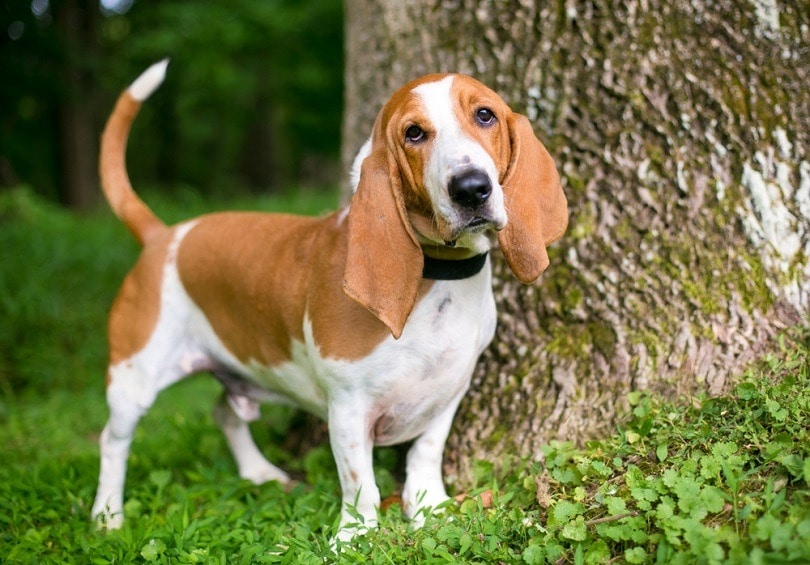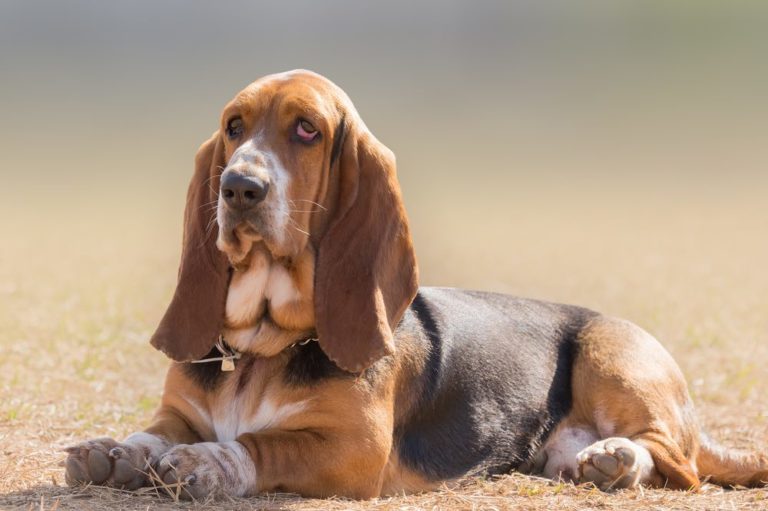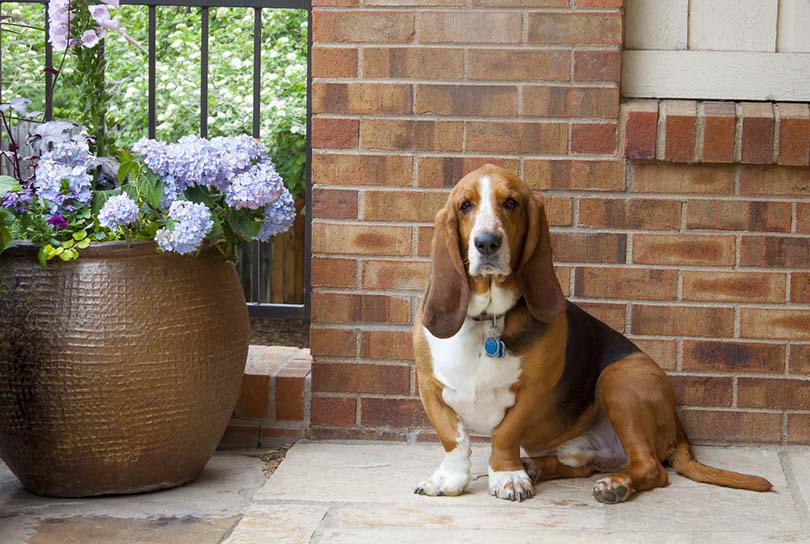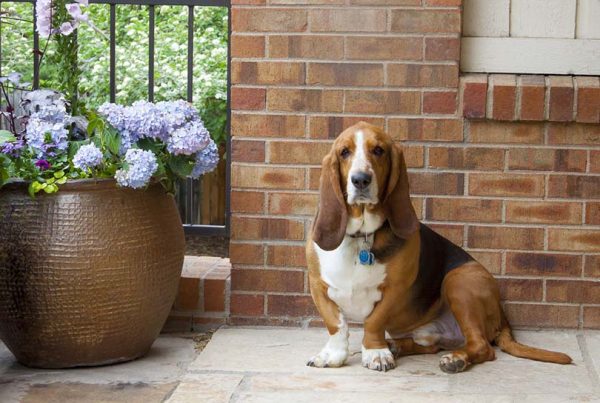When you see a Basset Hound dog with long, floppy ears walking your way, you know you’re in for a treat. Its coat is silky smooth, its face is wrinkly, and the belly barely touches the ground. The best part? This pooch is always happy to see you!
Basset Hounds found their place in our homes and even on popular shows, magazines, and comic books. But what did Basset Hounds do to deserve such recognition?
Basset Hounds have been around for centuries to hunt small game such as rabbits. At first, they were a choice dog for nobility but soon made their way into the common man’s home. We’re taking you on a leap through history to learn more about the droopy-faced pup. Let’s dive in.
Key Facts and Information
The Basset Hound is a low-riding hound known for its short legs and long, silky ears. Their faces are droopy and wrinkly, almost resembling a sad clown. They stand no taller than 14 inches at the shoulder but have a big dog personality. Their legs may be short, but they’re solid and fast.
Basset Hounds are moderate droolers with soft, short coats that hardly shed. This breed is highly affectionate and loves children. Most of the time, Bassets are ready to cuddle and relax. Sometimes this puts them at risk of obesity, so it’s best to watch caloric intake and ensure your Basset gets plenty of exercise. Otherwise, your Basset turns into a couch potato.
Basset Hounds have impeccable strength and stamina. Bassets are scent hounds and refuse to stop hunting until they locate the source. Many people don’t realize that the long ears on a Basset help “stir” the scent it’s tracking.
Bassets were bred to hunt in packs, so befriending other dogs usually isn’t an issue. A Basset’s loyalty to its owner equally matches its stubbornness, so they require a bit of training and patience. But their personality is charming, favorable, and mild.

The History of the Basset Hound
So, where did this breed come from anyway? As we previously mentioned, Bassets have been around for a long time—about a thousand years to be exact. Let’s jump through time and see how the Basset Hound came to be.
St. Hubert’s Hounds
The Basset Hound originated in 6th-century France from St. Hubert (c. 656–30 May 727 A.D.), the patron of dogs, hunters, and other trades.
St. Hubert initially worked in the Royal court. After his wife died, he left the court and focused entirely on hunting. The legend states that St. Hubert saw a stag with a crucifix between its antlers while in the forest. This sight led him to God, where he forever made his mark as the Saint of all things hunting.
St. Hubert used hound dogs when he hunted and even bred his own hounds in the Benedictine Abbey. Monasteries presented these hounds to the King of France as a sign of their loyalty.
It’s believed that the modern Basset Hound descended from these hounds. At this time, these hounds resembled more of a Bloodhound. They became officially known as St. Hubert Hounds in 1000 A.D.

The 1500s to the 1700s
Between St. Hubert’s time until the 1500s, it’s hard to pinpoint information regarding the Basset Hound. The word “Basset” means “low” in French. We read about Basset dogs during this time, but it’s unclear if Basset refers to the hound or if the term refers to several dwarf dogs.
We know that the Basset is a descendant of the Laconian hound, a hunting dog with short legs and upright ears. Ancient Greeks and Romans used this breed as protectors. Eventually, St. Hubert Hounds came to be known as Norman Staghounds. It’s thought that a genetic mutation in the Norman Staghounds created the Basset Hound.
Around 1573, the first mention of a Basset dog was used in Jacques du Fouilloux’s book La Venerie, an illustrated hunting book. At this time, Basset Hounds were only seen with French Monarchs for hunting outings.
The French Revolution (1789-1799) changed many societal norms, and soon the Basset Hound was seen in commoners’ homes.

The 1800s
The 1800s were when Basset Hounds started receiving recognition as a breed. In 1874, British painter Sir Everett Millais imported a Basset from France. He named his new Basset “Model.”
Sir Everett Millais is known as the Father of the Modern Basset. He popularized the breed in England and started a breeding program in his own kennel.
Sir Everett Millais entered a Basset Hound into the English dog show in 1875 and continued to enter more Basset Hounds. During this time, the Basset experienced some physical changes. The Basset Hound was crossed with the Bloodhound to increase its size.
Through his efforts, the breed was officially recognized in 1880. Word got out, and Princess Alexandra of Wales started keeping Basset Hounds in 1882.
It was a snowball effect from there! The Basset Hound Club was formed in 1884, and eventually, the Basset made its way to America. In 1885, the American Kennel Club recognized the first Basset Hound named Bouncer.

The 1900s
Unfortunately, the 1900s was a bit of a setback for the Basset Hound. World War I caused a population decline, much like many dog breeds. In 1914 to 1915, only nine Basset Hounds were registered with the American Kennel Club.
Between the 1920s and 1930s, a distemper outbreak struck several locations worldwide. The British Basset Hound club disbanded in 1921.
Luckily, the Basset Hound wasn’t forgotten. TIME magazine featured a Basset Hound on their cover in 1928, rekindling the love of Bassets! The Basset Hound Club of America started in 1933. Lionel Warner reformed the British Basset Hound club in 1954. The breed became popular in pop culture soon after. Elvis helped spread the Basset Hound love with his hit song Hound Dog, released in 1956.
In 1958, the world was introduced to Hush Puppy shoes, featuring a Basset Hound as their logo. This brand soon became internationally known.
In July of 1963, Scottish cartoonist Alex Graham launched the Fred Basset comic strip series. The series featured an adorable male Basset Hound named Fred and quickly found its way into several newspapers worldwide.
Conclusion
Although the creator of Fred Basset died, the comic strip series continues to this day all over the world. According to the American Kennel Club, since the resurrection of the Basset Hound, the breed ranks number 39 out of 204 breeds. This shows how loved the breed truly is.
Basset Hounds are loving, mild-mannered dogs with a snout that won’t stop sniffing. Although they’re stubborn, Basset Hounds love to snuggle and are loyal to their owners, making them an excellent addition to the family.
These dogs have a long history behind them. Their origin is hard to pinpoint, but we know they were considered valuable then, just like today.
See also:
- 10 Interesting Basset Hound Facts To Know (Vet Approved)
- How Much Do Basset Hounds Smell? What You Should Know
Featured Image Credit: Dr. Alan Lipkin, Shutterstock










